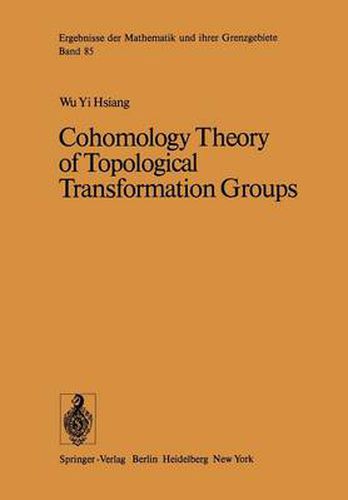Readings Newsletter
Become a Readings Member to make your shopping experience even easier.
Sign in or sign up for free!
You’re not far away from qualifying for FREE standard shipping within Australia
You’ve qualified for FREE standard shipping within Australia
The cart is loading…






This title is printed to order. This book may have been self-published. If so, we cannot guarantee the quality of the content. In the main most books will have gone through the editing process however some may not. We therefore suggest that you be aware of this before ordering this book. If in doubt check either the author or publisher’s details as we are unable to accept any returns unless they are faulty. Please contact us if you have any questions.
Historically, applications of algebraic topology to the study of topological transformation groups were originated in the work of L. E. 1. Brouwer on periodic transformations and, a little later, in the beautiful fixed point theorem ofP. A. Smith for prime periodic maps on homology spheres. Upon comparing the fixed point theorem of Smith with its predecessors, the fixed point theorems of Brouwer and Lefschetz, one finds that it is possible, at least for the case of homology spheres, to upgrade the conclusion of mere existence (or non-existence) to the actual determination of the homology type of the fixed point set, if the map is assumed to be prime periodic. The pioneer result of P. A. Smith clearly suggests a fruitful general direction of studying topological transformation groups in the framework of algebraic topology. Naturally, the immediate problems following the Smith fixed point theorem are to generalize it both in the direction of replacing the homology spheres by spaces of more general topological types and in the direction of replacing the group tl by more general compact groups.
$9.00 standard shipping within Australia
FREE standard shipping within Australia for orders over $100.00
Express & International shipping calculated at checkout
Stock availability can be subject to change without notice. We recommend calling the shop or contacting our online team to check availability of low stock items. Please see our Shopping Online page for more details.
This title is printed to order. This book may have been self-published. If so, we cannot guarantee the quality of the content. In the main most books will have gone through the editing process however some may not. We therefore suggest that you be aware of this before ordering this book. If in doubt check either the author or publisher’s details as we are unable to accept any returns unless they are faulty. Please contact us if you have any questions.
Historically, applications of algebraic topology to the study of topological transformation groups were originated in the work of L. E. 1. Brouwer on periodic transformations and, a little later, in the beautiful fixed point theorem ofP. A. Smith for prime periodic maps on homology spheres. Upon comparing the fixed point theorem of Smith with its predecessors, the fixed point theorems of Brouwer and Lefschetz, one finds that it is possible, at least for the case of homology spheres, to upgrade the conclusion of mere existence (or non-existence) to the actual determination of the homology type of the fixed point set, if the map is assumed to be prime periodic. The pioneer result of P. A. Smith clearly suggests a fruitful general direction of studying topological transformation groups in the framework of algebraic topology. Naturally, the immediate problems following the Smith fixed point theorem are to generalize it both in the direction of replacing the homology spheres by spaces of more general topological types and in the direction of replacing the group tl by more general compact groups.